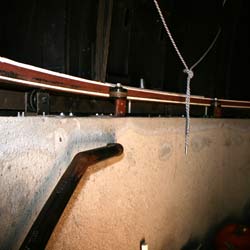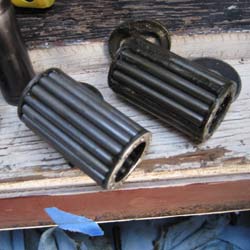Dome Rotation
At the start of this project, to rotate the dome would require the assistance of at least 3 adults. The effort required was far too great, and a suitable solution was found.
Background
| The dome of Kenneth Walker Observatory is 18 feet in diameter and weighs about 2000 pounds. There is a system of rollers that the dome rotates on, with 14 rolling wheels and 15 centering wheels in contact with steel plates attached to the wooden structure of the dome. |
 |
Research
| To begin the research, we looked at the different systems professional and amateur observatories use for dome rotation. We found there were two distinct styles. Larger, more professional observatories used a steel rail or pipe as a tack, which is secured to the foundation and the dome rides on rollers on the track. The other prevalent style was seen in many amateur and hobbyist observatories, and was the system in use at Kenneth Walker Observatory. |
 |
Design / Prototyping
After research was compete, we looked into the cost of installing a track system at Walker which would use a steel pipe mounted to the foundation and the dome would have two sets of rollers to rotate on the pipe. The main cost would be in hiring a crane to remove the dome to allow installation of the pipe. After quotes, the crane service would have cost a third of the budget, leaving little room for other sections of this project. Because of this, we decided to work with the existing system and improve what was already there. |
|
| Solutions to add mechanical assistance were tested during this time as well. First was a simple push bar that allowed a more ergonomic position when rotating the dome. With children around, we did not want to have a hanging steel bar be a safety hazard of be seen as a toy. |
 |
| The other idea tested was to have a wheel attached to a crank that rotated the dome. This issue with this system is it requires three sets of wheels, so for our goal of only one operator required to rotate the dome, a hand cranked system would not work. The wheels would have to be motorized and the budget didn’t allow for such a solution. |
 |
Final Solution
| Upon inspection, many of the wheels the dome was supported by were never touching the bottom surface of the dome. This increased the load on the remaining wheels, adding rolling resistance. As a solution, we leveled the height of all wheel supports by shimming them to the proper height. Even with the dome being slightly warped, a difference could already be felt in rotating the dome. | |
| Next, we disassembled every wheel and cleaned out the bearings. We inspected the bearings and wheel surfaces for any excessive wear and damage. Once satisfied, we greased the bearings and reassembled the wheel assemblies. In addition, with the guidance of Ralph Nye of Lowell Observatory, we lubricated all steel surfaces of the dome in contact with the wheels with silicone grease to further decrease rolling resistance. |
 |